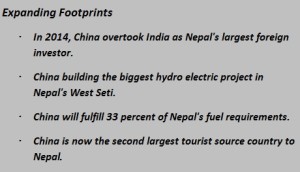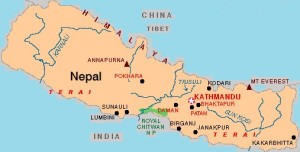–
MANTRAYA ANALYSIS#05: 10 NOVEMBER 2015
Dragon in the Himalayas: Expanding Chinese footprints in Nepal
Bibhu Prasad Routray
–
Abstract
Chinese footprints in Nepal have consistently expanded in the past decade. Not only that the Chinese investments in the country have increased substantially overtaking India as the largest investor, Mandarin is being seen as the language of the future by the Nepalese youth. Whether New Delhi can deal with this development by overplaying its geographic advantages must remain a matter of serious debate.
–
On 14 January 2012, Chinese Premier Wen Jiabao undertook a four and half hour visit to Kathmandu. Wen was the highest level Chinese leader to visit Nepal in a decade. Among various requests Nepal made to the Chinese premier was a 100 percent increase in the 100 million Yuan annual aid Nepal received from Beijing; extension of the railway line that China was building up to the Sino-Nepal border to Kathmandu and Lumbini; and allowing Nepali citizens residing within 30 kilometres of the Sino-Nepal border to use the pasture and graze their livestock on the other side of the border. Not just all of Kathmandu’s wishes were granted, Wen showered much more on the Himalayan kingdom.
Eight agreements including economic and technical assistance agreement with a grant assistance of 750 million Yuan for the next three years for the development of mutually agreed projects were signed. Wen also pledged special grant assistance of $20 million for financing rehabilitation of Maoist combatants. China further pledged financial and technical assistance worth 10 million yuan to enhance capability of Nepal Police. Another technical assistance package of 400,000 yuan was signed for strengthening the Armed Police Force (APF).
These agreements, far from being customary pledges usually made during high profile visits, were a continuation of Beijing’s active interest in Nepal in years prior to Mr. Wen’s visit. And the trend of the rising Chinese aid and investment profile has been sustained since then. China is building infrastructure for transport, telecommunications and hydroelectric power in Nepal. Wide ranging Investments have also been made in sectors including hotels and restaurants, electronics, readymade garment, medical services and civil construction.
Nepal ranks second in water resources in the world. More than 5000 small and big rivers flow in Nepal with an estimated hydro power potential of 83,000 megawatt (MW). Of this only 650 MW are being currently produced. In 2012, the China Three Gorges conglomerate signed a deal to invest $1.6bn in the 750-megawatt hydropower project in West Seti, in Nepal’s northwestern Doti district. West Seti project is described as one of the largest power projects in the country. In early 2015, the Nepal investment board cleared the project after the conglomerate threatened to pull out its support after waiting for three years for clearance. Financing for the US$1.6 billion plant is being provided by China Three Gorges and the Export-Import Bank of China. The investment represents China’s largest investment into Nepal, which is estimated to have at least 40,000 MW of hydroelectric potential. While construction of the West Seti plant is scheduled to begin shortly, the plant’s first generating units will come on line in 2019. The majority of the project’s output will be sold to Nepal.
Nepal figures prominently in Beijing’s Silk Road economic belt project. Here Chinese ambitions syncs well with Nepal’s aspirations for having better road and air connectivity with China to spur the globalisation of the Nepalese economy. While connectivity with India is seen as a critical and yet disruption prone supply route, road and rail links with China is being seen as means by which Nepalese goods will be able to find international markets. Not surprisingly, in December 2014, Nepal backed China’s Silk Road economic belt project by signing a four point document at the Nepal-China Inter-governmental Business and Investment Coordination meeting in Beijing. In March 2015, Beijing said it would extend a $145 million grant for the upgrade of a 114-kilometres road that links the capital Kathmandu with the Tibetan border, as well as other infrastructure projects. China wants to connect with Nepal and South Asia through an extension of the Qinghai-Tibet railway. The rail line from Lhasa has already been extended to Shigatse, Tibet’s second largest city, 253 kilometres away. The Chinese plan to build two lines from Shigatse. One would lead to Kerung, the nearest Chinese town from Nepal, from where it would be extended to Rasuwagadhi in Nepal. The other line would head to Yadong on the India-Bhutan border. Once a rail connection with China is established, Nepalese goods can be transited to the international markets through the Eurasian transportation network.
Both countries have also agreed to construct and manage dry ports along the six Nepal-China border points in a bid to facilitate bilateral trade and people´s movement. Of this the ones at Yari-Pulam, Rasuwa-Jilong and Kodari (Tatopani)-Zangmu (Khasha) are international-standard dry ports and cargo terminals and the ones at Kimanthanka-Dingri, Olangchungola-Riwu and Mustang-Ligzi are bilateral standard. China further agreed to expedite the implementation of Tatopani Dry Port and upgrading and expansion of the existing Ring Road in the Kathmandu Valley.
In August 2011, Nepal Telecom, the government-controlled telecom monopoly, awarded the contract for installing the Next Generation Network (NGN) to two Chinese telecom firms, ZTE Corporation and Huawei. While ZTE installed the equipment for NGN in Kathmandu Valley while Huawei did so in the rest of Nepal at a combined cost of $19 million. ZTE, China’s largest wireless equipment manufacturers and network solutions providers with close ties with the People’s Liberation Army (PLA) in 2012 built four high-technology earthquake-resistant data centres for Ncell Pvt Ltd, a Nepalese telecom company in at a cost of about $43.75 million at Biratnagar, Kathmandu, Hetauda and Pokhara. In 2014, Huawei started its commercial operations in Nepal. In addition to the existing trans-border Tatopani optical fibre connection with China set up in 2010-11, Nepal Telecom set up the second Rasuwagadhi optical fibre connection with Beijing in early 2015. Among Nepali social media users, China’s mobile messaging app WeChat appears to be the most popular means of communication.
In 2014, China overtook India as Nepal’s largest foreign investor. A report by Nepal’s Department of Industry said that Chinese investments reached $174 million between July and December 2014, accounting for over 60 percent of the total FDI commitment. This marked a three-fold rise from the $55 million investment in the same period in the 2011-12 fiscal year, when India was the biggest source of FDI in that country. Much of this has been possible under the sustained efforts of the Federation of Nepalese Chambers of Commerce and Industry (FNCCI), especially under the framework of Nepal-China Non-Governmental Cooperation Forum established in 1996, which is working towards attracting Chinese investment to the country. The 12th meeting of the forum took place in 2013 in Beijing.
Among projects completed in the health sector is the construction of the 150-bed B.P. Koirala Memorial Cancer Hospital (1999) at the cost of $11.7 million, the 120-bed Civil Service Hospital (2006) at the cost of $16 million and the National Ayurveda Research and Training Centre at the cost of 7.14 million (2009). In July 2015, Nepal also endorsed a Foreign Direct Investment (FDI) proposal worth $360 million made by China’s Hongshi Holdings Limited to establish a cement plant in Nepal in partnership with Nepal’s Shivam Cement.
China is now the second largest tourist source country to Nepal. Such flow of tourists have increased phenomenally since 2009. According to Nepal’s Ministry of Culture, Tourism and Civil Aviation, while 32,272 Chinese tourists visited Nepal in 2009, in 2013, the number of increased to 113,173 in 2013, registering a 250 percent growth. Correspondingly, the number of weekly flights between Chinese cities and Nepal has gone up to 70. Chinese nationals have started investing in the hotel industry in Nepal’s tourist destinations. In Thamel and Pokhra for example, a number of hotels are owned by the Chinese nationals using business licenses issued by the Nepalese government. A clear pointer of the demographic shift in tourism from majority European backpackers to Chinese tourists is the unofficial renaming of a part of Thamel as Chinatown.
As the Chinese investment and tourism takes a leap Beijing is encouraging the Nepalese people to learn Chinese. In the past years, several private centres offering lessons in Mandarin have sprung up in Kathmandu and other cities catering to the increasing demand of the young who genuinely believe the language will be a pathway to a good career. In addition, instructors from Beijing have also landed in Kathmandu to give free lessons in Mandarin and set up the Confucius Centre at Kathmandu University to “spread Chinese language and culture”. China has also doubled the number of scholarships previously at 100 to attract Nepalese students.
Beijing has termed Nepal a corridor connecting China to South Asia, a position that was once endorsed by former Nepalese Prime Minister Baburam Bhattarai who said, “Nepal will be a friendship bridge between China and India.” However, this stated position of playing only a bridge is changing, partly due to India’s hardline position and partly due to a conscious policy on part of Kathmandu. The new Nepalese Prime Minister Khadga Prasad Sharma Oli has stated that he will strengthen bilateral ties with China and India. In an interview to the Xinhua newspaper Oli also expressed his commitment to maintaining Nepal’s long-standing one-China policy, saying Nepal will not allow any external forces in its territory to work against China’s core interests.
On 28 October 2015 both countries entered into an agreement for import of oil. The agreement followed China’s pledge a week earlier to provide 1000 metric ton (1,300 kilolitres) of fuel to Nepal in grant after blockades along the Indo-Nepal border created a serious fuel crisis in the country. The agreement, viewed by some in New Delhi as alarming is a part of the continuing trend of expanding Chinese footprints in Nepal. Whether New Delhi can deal with this development by overplaying its geographic advantages must remain a matter of serious debate in the coming months.
–
(Dr. Bibhu Prasad Routray is Director of Mantraya.org)
To read previous Mantraya Analyses CLICK HERE



